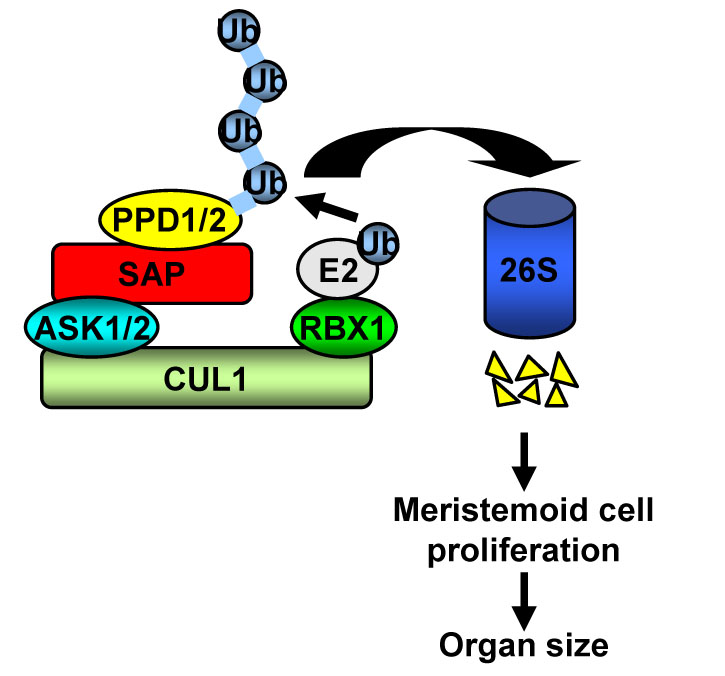Meristemoids are stem cell-like cells that are dispersed in the leaf epidermis. In the model plant Arabidopsis thaliana, 67% of all pavement cells in cotyledons and 48% in leaves originate from the division of meristemoids. However, the molecular mechanisms of meristemoid cells in organ size control remain largely unknown.
The group of Prof. LI Yunhai from the Institute of Genetics and Developmental Biology, Chinese Academy of Sciences (CAS), collaborated with Prof. WANG Yingchun from the Institute of Genetics and Developmental Biology, CAS and Prof. INZE Dirk from Ghent University, Belgium, reported that the F-box protein STERILE APETALA (SAP) controls organ size by promoting the proliferation of meristemoid cells.
Researchers from Prof. LI Yunhai’ group previously demonstrated that the ubiquitin receptor DA1 regulates organ size by restricting cell proliferation in Arabidopsis. Recently, they have isolated a suppressor of da1-1 (sod3-1), which affects organ size by decreasing meristemoid cell proliferation. The sod3-1 is further identified as a mutant allele of SAP, which is known to regulate flower development, but its function in organ size control has not been reported. Overexpression of SAP caused large leaves and flowers due to increased meristemoid cell proliferation, indicating that SAP is a positive regulator of meristemoid cell proliferation and organ size.
They revealed that SAP is a novel F-box protein with a WD40-like domain. SAP physically associates with ASK1 (ARABIDOPSIS SKP1-LIKE 1), ASK2 (ARABIDOPSIS SKP1-LIKE 2) and CUL1 (CULLIN) to form SCFSAP E3 ubiquitin ligase complex. They further discovered that SAP physically associates with and modulates the stability PPD proteins, which are known to regulate organ size by restricting meristemoid cell proliferation. SAP and PPD function in a common genetic pathway to control meristemoid cell proliferation. They defined a genetic and molecular mechanism by which SAP regulates organ size at least in part by targeting PPD proteins for proteasome-dependent degradation.
This work entitled “SCFSAP controls organ size by targeting PPD proteins for degradation in Arabidopsis thaliana” has been published online in Nature Communications (DOI: 10.1038/NCOMMS11192) with WANG Zhibiao from LI Yunhai’s group as the first author.
This research was supported by the National Natural Science Foundation of China and the Ministry of Agriculture of China.

Figure. SAP controls organ size by targeting PPD proteins for degradation (Image by IGDB)
AUTHOR CONTACT:
Dr. LI Yunhai
Institute of Genetics and Developmental Biology, Chinese Academy of Sciences, Beijing, China
E-mail: yhli@genetics.ac.cn



